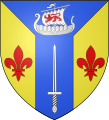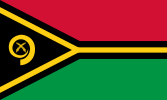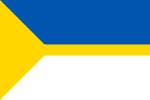
Heraldry is a discipline relating to the design, display and study of armorial bearings, as well as related disciplines, such as vexillology, together with the study of ceremony, rank and pedigree. Armory, the best-known branch of heraldry, concerns the design and transmission of the heraldic achievement. The achievement, or armorial bearings usually includes a coat of arms on a shield, helmet and crest, together with any accompanying devices, such as supporters, badges, heraldic banners and mottoes.
In heraldry, tenné is a "stain", or non-standard tincture, of orange, light brown or orange-tawny colour.

Tinctures are the colours, metals, and furs used in heraldry. Nine tinctures are in common use: two metals, or and argent ; the colours gules (red), azure (blue), vert (green), sable (black), and purpure (purple); and the furs ermine, which represents the winter fur of a stoat, and vair, which represents the fur of a red squirrel. The use of other tinctures varies depending on the time period and heraldic tradition in question.
In heraldry, variations of the field are any of a number of ways that a field may be covered with a pattern, rather than a flat tincture or a simple division of the field.

An abatement is a modification of a coat of arms, representing a less-than honorable augmentation, imposed by an heraldic authority or by royal decree for misconduct. The practice of inverting the entire escutcheon of an armiger found guilty of high treason has been attested since the Middle Ages and is generally accepted as reliable, and medieval heraldic sources cite at least one instance of removing an honourable charge from a coat of arms by royal decree as an abatement of honour. Other abatements of honour implied by the addition of dishonourable stains and charges, appearing in late 16th-century texts, have never been reliably attested in actual practice. Additionally, as many heraldic writers note, the use of arms is not compulsory, so armigers are more likely to relinquish a dishonored coat of arms than to advertise their dishonor.
In heraldry, an ordinary is one of the two main types of charges, beside the mobile charges. An ordinary is a simple geometrical figure, bounded by straight lines and running from side to side or top to bottom of the shield. There are also some geometric charges known as subordinaries, which have been given lesser status by some heraldic writers, though most have been in use as long as the traditional ordinaries. Diminutives of ordinaries and some subordinaries are charges of the same shape, though thinner. Most of the ordinaries are theoretically said to occupy one-third of the shield; but this is rarely observed in practice, except when the ordinary is the only charge.
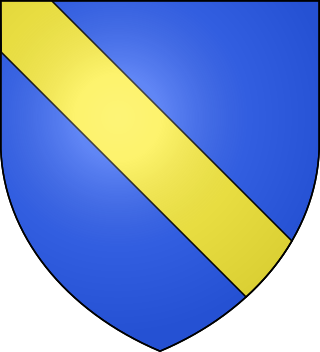
In heraldry, a bend is a band or strap running from the upper dexter corner of the shield to the lower sinister. Authorities differ as to how much of the field it should cover, ranging from one-fifth up to one-third.
In heraldry, a charge is any emblem or device occupying the field of an escutcheon (shield). That may be a geometric design or a symbolic representation of a person, animal, plant, object, building, or other device. In French blazon, the ordinaries are called pièces, and other charges are called meubles.
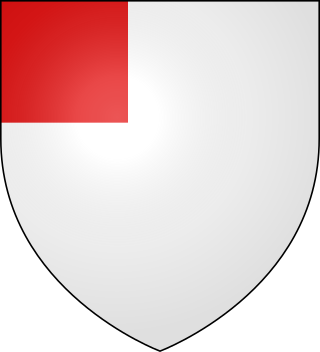
In heraldry, a canton is a charge placed upon a shield. It is, by default a square in the upper dexter corner, but if in the sinister corner is blazoned a canton sinister. A canton is classed by some heraldic writers as one of the honorable ordinaries; but, strictly speaking, it is a diminutive of the quarter, being two-thirds the area of that ordinary. However, in the armorial roll of Henry III, the quarter appears in several coats which in later rolls are blazoned as cantons. The canton, like the quarter, appears in early arms, and is always shown with straight lines.

Ermine in heraldry is a fur, a type of tincture, consisting of a white background with a pattern of black shapes representing the winter coat of the stoat. The linings of medieval coronation cloaks and some other garments, usually reserved for use by high-ranking peers and royalty, were made by sewing many ermine furs together to produce a luxurious white fur with patterns of hanging black-tipped tails. Due largely to the association of the ermine fur with the linings of coronation cloaks, crowns and peerage caps, the heraldic tincture of ermine was usually reserved to similar applications in heraldry. In heraldry it has become especially associated with the Duchy of Brittany and Breton heraldry.
In heraldry and heraldic vexillology, a blazon is a formal description of a coat of arms, flag or similar emblem, from which the reader can reconstruct the appropriate image. The verb to blazon means to create such a description. The visual depiction of a coat of arms or flag has traditionally had considerable latitude in design, but a verbal blazon specifies the essentially distinctive elements. A coat of arms or flag is therefore primarily defined not by a picture but rather by the wording of its blazon. Blazon is also the specialized language in which a blazon is written, and, as a verb, the act of writing such a description. Blazonry is the art, craft or practice of creating a blazon. The language employed in blazonry has its own vocabulary, grammar and syntax, which becomes essential for comprehension when blazoning a complex coat of arms.

French heraldry is the use of heraldic symbols in France. Although it had a considerable history, existing from the 12th century, such formality has largely died out in France, as far as regulated personal heraldry is concerned. Civic heraldry on the other hand remains a visible part of daily life.

In English heraldry, the bar is an heraldic ordinary consisting of a horizontal band extending across the shield. In form, it closely resembles the fess but differs in breadth: the bar occupies one-fifth of the breadth of the field of the escutcheon ; the fess occupies one-third. Heraldists differ in how they class the bar in relation to the fess. A number of authors consider the bar to be a diminutive of the fess. But, others, including Leigh (1597) and Guillim (1638), assert that the bar is a separate and distinct ‘honorouble ordinary’. As an honourable ordinary, it is co-equal with the other nine of the English system. Some authors who consider the bar a diminutive of the fess class it as a subordinary. Authorities agree that the bar and its diminutives have a number features that distinguish them from the fess.

Dexter and sinister are terms used in heraldry to refer to specific locations in an escutcheon bearing a coat of arms, and to the other elements of an achievement. Dexter indicates the right-hand side of the shield, as regarded by the bearer, i.e. the bearer's proper right, and to the left as seen by the viewer. Sinister indicates the left-hand side as regarded by the bearer – the bearer's proper left, and to the right as seen by the viewer. In vexillology, the equivalent terms are hoist and fly.
A gyron is a triangular heraldic ordinary having an angle at the fess point and the opposite side at the edge of the escutcheon. A shield divided into gyrons is called gyronny, the default is typically of eight if no number of gyrons is specified. The word gyron is derived from Old French giron, meaning 'gusset'. When a single gyron extends across so the tip touches the edge of the coat of arms, forming a square, it is called an esquire.
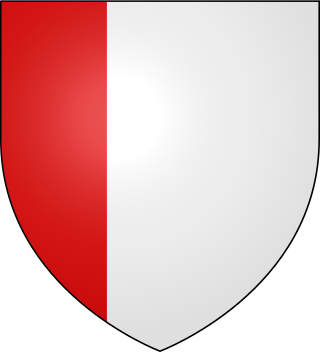
The side, or flank, is a heraldic ordinary resembling a pale that has been displaced to either the dexter or sinister edge of the field. Pierre-Barthélemy Gheusi, following M. Aug. Tailhades, groups the sides with the chief and base as ordinaries that are affixed to an edge of the field by their longest side.
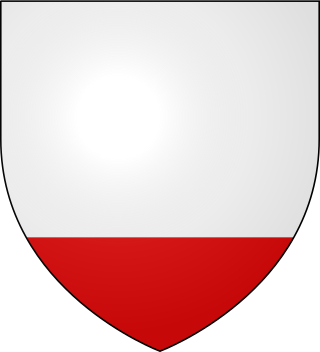
The base, more formally the terrace in base or champagne, is a heraldic charge that occupies the lower third of the field. It is in that sense the inverse correlate of the chief. In French heraldry, the champagne is considered an "honourable ordinary", but in English heraldry, it is frequently omitted from lists of the honourable ordinaries, and grouped, if at all, with the subordinaries. The diminutive of the base, occupying one half the height of the ordinary, is termed plaine in French heraldry. Another, now less common, English language term for the base is the foot, a usage the recalls the German Schildfuß, Danish skjoldfod, and Dutch schildvoet.
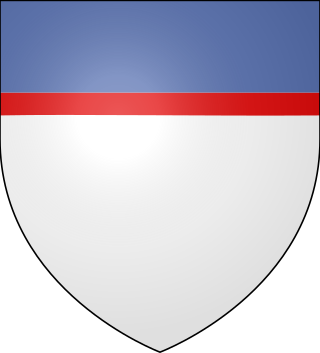
In English-language heraldry, the fillet is considered a diminutive of the chief. It is defined as occupying one fourth the width of the chief and typically positioned at its bottom edge. When so positioned the chief is blazoned as supported by the fillet; but, when the chief is charged by the fillet, as when the fillet positioned at its top edge or middle, the chief is blazoned as surmounted. In French heraldry, terms for this charge are divise and filet en chef. The term chef retrait has also been used. The fillet or divise placed beneath the chief is of a different tincture than the field, evidently to avoid violations of the rule of tincture.
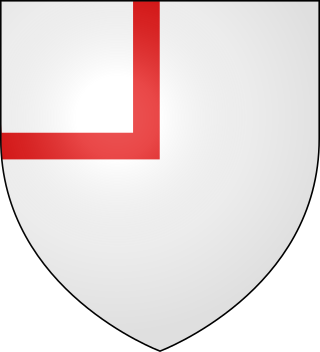
Esquarre is a name for both a heraldic ordinary and a set of related mobile charges. As an ordinary, the Esquarre is defined as a charge that borders a quarter on its two interior edges abutting the field. The Esquarre isolates the quarter from the rest of the field. De Galway suggested that the Esquarre is employed when both quarter and field are the same tincture. The shape of the ordinary is likened to a carpenter's square, a tool formed of two arms joined perpendicularly. When the two arms are of unequal length, the term potence (Fr.) is also used, a term likening the form of this variant to a joined post and crossbeam, or gallows/scaffold.
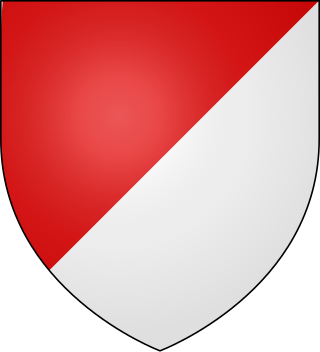
The Esquire is a heraldic charge that is classed as a subordinary in Anglophone heraldry. Its form is defined as resembling the Gyron, as formed of a right triangle; but, with the difference that whereas the Gyron extends from the outer edge of the field to the center, the Esquire extends across the whole of the field, from one edge to its opposite.






